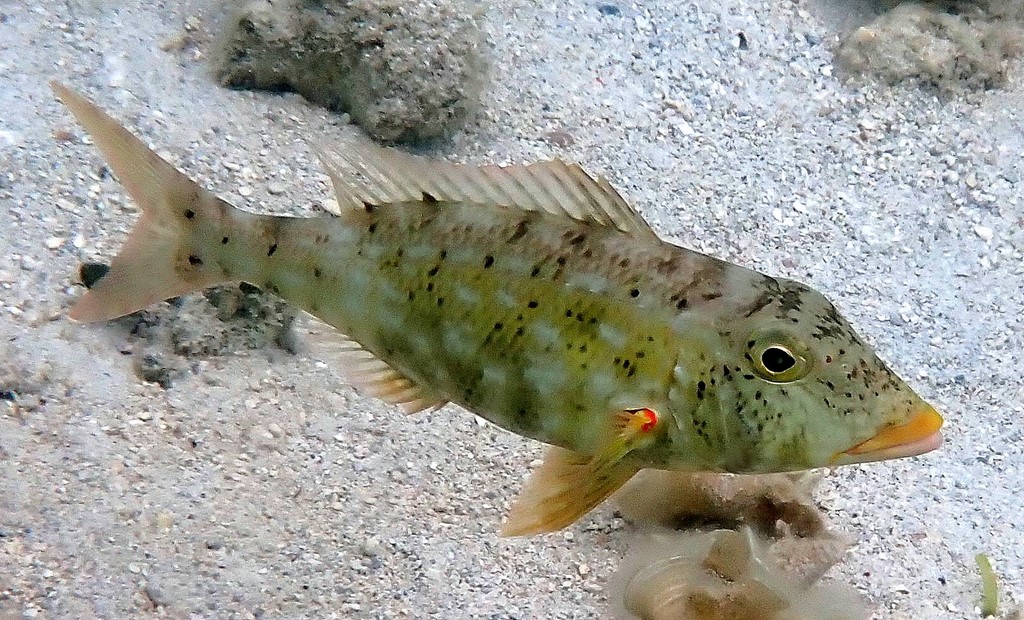LETHRINUS XANTHOCHILUS - (KLUNZINGER, 1870)
Picture courtesy of: Claire Goiran
Empereur bec de cane, Gueule d’acier, Bec de cane à lèvres jaunes, Bec-de-cane à museau court, Klunzinger's emperor, Red-spot emperor, Yellowlip emperor, Geellip-keiser, Barrois, Gullæbet kejserbrasen, Gelblippen-Strassenkehrer, Ladrão de boca amarela, Emperador trompa amarilla, Muneaka-kuchibi, ムネアカクチビ, 黃唇遺頰鯛, 红胸龙占,
Synonymes
Lethrinella xanthocheilus (Klunzinger, 1870)
Lethrinella xanthochila (Klunzinger, 1870)
Lethrinella xanthochilus (Klunzinger, 1870
Lethrinus xanthocheilus (Klunzinger, 1870)
Lethrinus xantochilus (Klunzinger, 1870)
----------------------
Description
Dorsal spines (total): 10; Dorsal soft rays (total): 9; Anal spines: 3; Anal soft rays: 8; Pectoral fin rays: 13; Greatest body depth: 2.6-2.9 in SL; Interorbital area distinctly concave. Lateral line scales: 47-48; Scales in supratemporal patch: 5-8; Cheek scaleless; Inner base of pectoral fin scaleless; No molars in jaws; Scale rows between lateral line and mid-dorsal-fin spines: 4½; A distinct angularity in dorsal profile of head above front of eye. Dense melanophores on innermost pelvic fin membranes. Max. length: 70.0 cm FL, common length: 59.0 cm SL. Max. published weight: 5.4 kg. Depth range: 5 - 150 m.
Color
Body is yellowish gray with scattered irregular dark spots; Lips yellowish, the upper lip more intense; A red spot at upper base of the pectoral fin. The fins are bluish grey and mottled, the bases of the fins are lighter and the edges of the dorsal and caudal fins are reddish.
Etymology
Lethrinus: from Greek, lethrinia, a fish pertaining to genus Pagellus (Pagellus erythrinus (Linnaeus, 1758)), a Mediterranean fish looking like Lethrinidae family.
xanthochilus: from Greek, xanthos = yellow or blond + from Greek, cheilos = lip. Referring to its yellowish lips, the upper lip more intense.
Original description: Lethrinus xanthochilus Klunzinger, 1870 - Type locality: Al-Qusair, Red Sea Governorate, Egypt, Red Sea.
Distribution
Red Sea; Indo-West Pacific: East Africa, Seychelles, Madagascar and western Mascarenes, east to Marshall Islands, Marquesas Islands and Gambier Islands, north to Ryukyu Islands (southern Japan), south to Rowley Shoals (Western Australia), New Caledonia and Tonga.
Body is yellowish gray with scattered irregular dark spots; Lips yellowish, the upper lip more intense; A red spot at upper base of the pectoral fin. The fins are bluish grey and mottled, the bases of the fins are lighter and the edges of the dorsal and caudal fins are reddish.
Etymology
Lethrinus: from Greek, lethrinia, a fish pertaining to genus Pagellus (Pagellus erythrinus (Linnaeus, 1758)), a Mediterranean fish looking like Lethrinidae family.
xanthochilus: from Greek, xanthos = yellow or blond + from Greek, cheilos = lip. Referring to its yellowish lips, the upper lip more intense.
Original description: Lethrinus xanthochilus Klunzinger, 1870 - Type locality: Al-Qusair, Red Sea Governorate, Egypt, Red Sea.
Distribution
Red Sea; Indo-West Pacific: East Africa, Seychelles, Madagascar and western Mascarenes, east to Marshall Islands, Marquesas Islands and Gambier Islands, north to Ryukyu Islands (southern Japan), south to Rowley Shoals (Western Australia), New Caledonia and Tonga.
Biology
Occurs in small groups over seagrass beds, sand and rubble areas of coral reefs, deep channels, and lagoons. Usually found in shallow water. Usually seen solitary but sometimes swims in small groups. Juveniles in seagrass beds. Feeds mainly on crustaceans, fishes, and echinoderms.
Similar species
Lethrinus obsoletus (Forsskål, 1775) - Reported from New Caledonia - Link to the species (here).
Lethrinus olivaceus (Valenciennes, 1830) - Reported from New Caledonia.
Occurs in small groups over seagrass beds, sand and rubble areas of coral reefs, deep channels, and lagoons. Usually found in shallow water. Usually seen solitary but sometimes swims in small groups. Juveniles in seagrass beds. Feeds mainly on crustaceans, fishes, and echinoderms.
Similar species
Lethrinus obsoletus (Forsskål, 1775) - Reported from New Caledonia - Link to the species (here).
Lethrinus olivaceus (Valenciennes, 1830) - Reported from New Caledonia.
Last update: 10, June 2024
